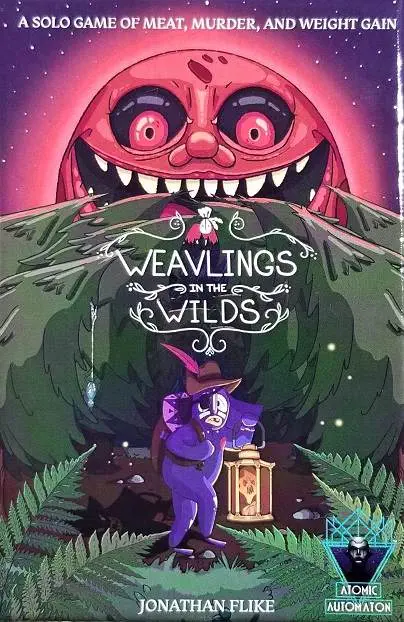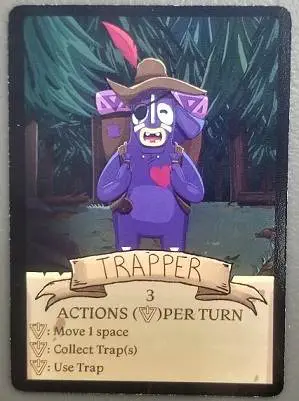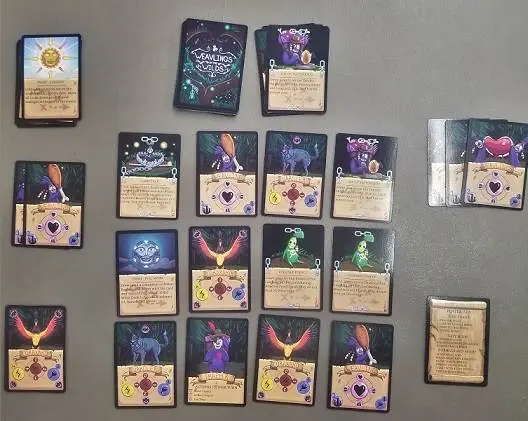
Dieting. We all hate it if we’re being honest, which is why it is hard to fault the Weavlings for escaping their mistress (legendary Fate Weaver Zadarra) and hunting down extra snacks for themselves. The Tender Wilds, however, is not the safest of locations to try looking for food. The wilds are filled with dangerous Beasties with a penchant for gobbling up chubby little Weavlings as well as other strange happenings waiting to be encountered. As a solo game, it is up to the player to take on the role of Trapper and venture out into the Tender Wilds, trap the local wildlife, and use the tasty meats to lure the Weavlings home.
Weavlings in the Wilds is an upcoming card-crawler from Atomic Automaton and artist/designer Jonathan Flike. One of the things that really stuck with us in the months after the game’s announcement was the artwork and style Flike uses. In some ways, the art is very reminiscent of the darker Studio Ghibli animation style but also brings to mind the Cartoon Saloon art found in the Irish Folklore Trilogy. The world represented in the game, though dark, can still appeal to players of most ages and skill levels thanks to the multiple variations of gameplay presented in the rulebook. These adaptations allow the game to adapt to the player and their preferences. The crowdfunding campaign for Weavlings in the Wilds starts in just a few days as of the posting of this review and should be on the radar of anyone who enjoys involved and constantly changing puzzle-like challenges.

We will be the first to admit that the prototype rulebook was not the easiest for us to digest through reading alone (it was a bit vague, but has been edited several times since our copy arrived and is much improved) and it took a few rounds for us to overcome the learning curve and understand all of the mechanics. This should not, however, discourage anyone from trying the game. Once the mechanics click, Weavlings in the Wilds can be a fun 20-30 minute hunting pursuit. While in the role of the Trapper, the environment around you and its elements are constantly shifting as they are interacted with, causing the player to plan as best they can for each action taken. Picking up known (face up) cards will have them replaced with facedown ones, creating more and more unknowns while traipsing through the wilds each round. Different spirits, beasties, and traps will all interact differently with the environment, causing no two games to play the same. There are even multiple expansions that can be used to create even more variation and replayability.
Setting up is a breeze and we really appreciated that the game is not a table hog like some solo games have turned out to be. The Weavling, Event, Beastie, and Trap cards are shuffled together and laid out in a facedown 4×3 grid, leaving space around the outside for various discard piles and the draw deck. The player chooses any space from the grid, discards that card face up, and places the Trapper where the chosen card was removed from. All of the facedown cards are then flipped face up, revealing the Trapper’s surroundings and immersing the player in the Tender Wilds. While in the wilds, players will collect traps, use said traps to collect or fend off encountered beasties, and lure the Weavlings back home with succulent beastie meats. All this is done over the course of several rounds until either the player has collected or lost ten or more points in Weavlings or accumulated ten or more wounds.
To play through a round, the player will first have the Trapper perform a series of actions in what is known as the Trapper Phase. Collecting adjacent Spirit cards does not cost any of the three available action points, but choosing to move by swapping places with an adjacent card, picking up nearby traps, or setting those traps to capture the beasties will. It should be noted that any time an empty space is created, the cards further up in the column will “fall” down to fill the gap. In this way, the board is constantly changing as actions are taken both by the player and the beasties. Once the first phase is finished, the player may then spend meat from their collected hand to lure Wildlings into their saved population pool, but should know that any excess meat spent on a target is lost. The third phase has the beasties hunting their surroundings and eating Wildlings according to their speed factor and the direction of the icons on their individual cards. A beastie that eats will be taken off the map, but should they not find any unfortunate Wildlings to fill their bellies, they will remain and continue to hunt. Lastly, all face-up cards on the bottom row will fall off and facilitate the idea of moving deeper into the wilds as new cards are drawn to fill the newly empty spaces. Facedown cards are revealed and a new round begins. We will leave it to the readers to discover the rules for resolving events that show up, as well as the special abilities of traps, spirits, and certain beasties along the way. These abilities are a great part of the game, yet have already had a few minor tweaks since we received our copy, and who is to say what will be discovered as the Kickstarter campaign unfolds?

Currently, there are two expansions for Weavlings in the Wilds: Zadarra’s Baubles and Brews and Star-touched Predators. Not only do these add new cards and combos to the game, but they can be used separately or together when combined with the base game. Zadarra’s Baubles and Brews allows players to swap out some or all of the traps from the base game for new ones, allowing for more diversity when trying to capture beasties. There are limitations, of course, as the number of traps used in a game is finite. When swapping out base game cards for expansion cards, it must be done on a one-to-one basis established by trap rank. The types of traps in the game can be as varied as desired while sticking to the confines of the total amount of traps allowed. Much like the name implies, Star-touched Predators adds new and more powerful beasties to be encountered in the Tender Wilds. Unlike picking and choosing what traps to include from Zadarra’s Baubles and Brews, the beastie and event cards from Star-touched Predators will fully replace those in the base game. Star-touched Predators‘ beasties are much more of a challenge to face as they have a stronger bite (upgraded from “Chomp” to “Devour”) and come with their own abilities. This expansion is great for players that have gotten the hang of the base game and want a bigger challenge.
With or without the expansions, Weavlings in the Wilds is a tight, puzzle of a game that can quickly reach its crescendo while pushing the player to make quick and smart decisions in order to succeed before they run out of time. Even with the “beat the clock” aspect, we appreciate that the game can be made to be as challenging as you want to make it for yourself. Weavlings in the Wilds’ replayability and scaling difficulty make it a great option for solo gamers as there is quite a bit of game within the box and it is a puzzle worth coming back to again and again. Additionally, the artwork is attention-grabbing on and off the shelf and works really well with the theme – it certainly drew us to the game from the get-go! The Kickstarter campaign launches soon, so we hope you join us there as backers!
All photos of Atomic Automaton products were taken by Krista. As this is a prototype, it may not truly represent the final product.

